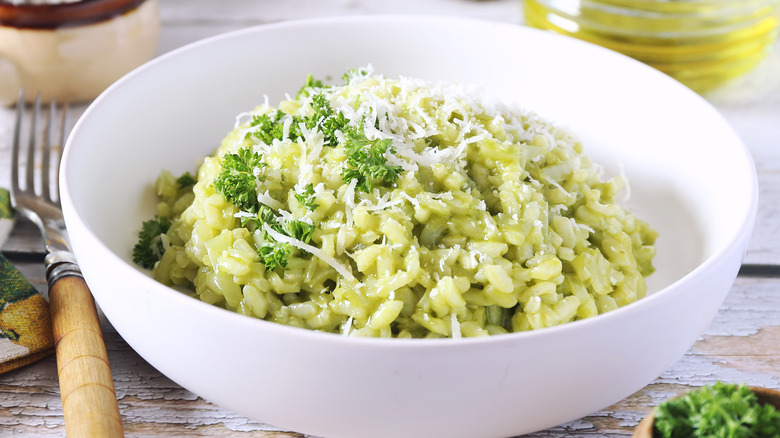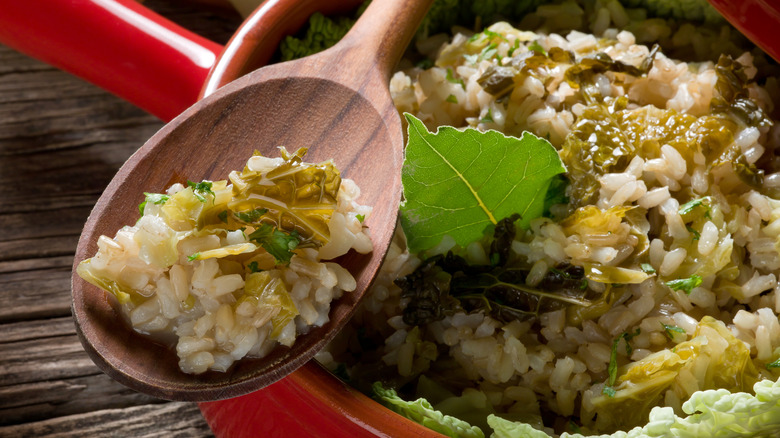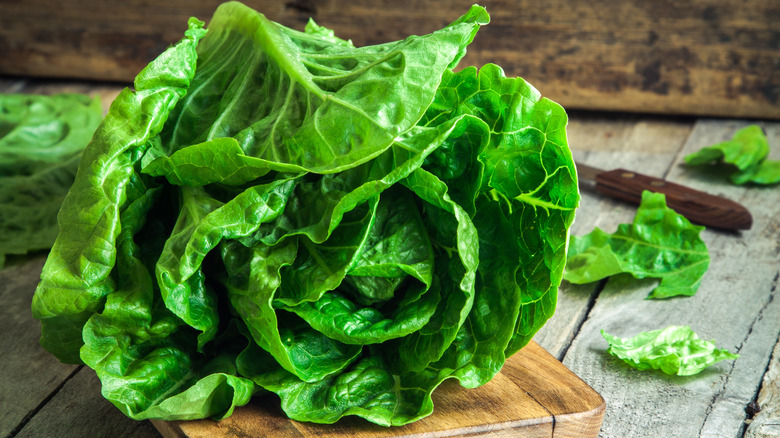Seriously, Use Lettuce To Give Risotto A Huge Flavor Upgrade
When you think of risotto, the usual suspects for add-ins likely include mushrooms, seafood, or saffron. But the beauty of this classic Italian dish is that it's a blank slate for flavor. Rice is naturally absorbent, and as it cooks, it will soak up the flavors of any broth, seasoning, or other ingredient you add to it. Lettuce is probably the last ingredient you'd think to add, but as celebrity chef Lidia Bastianich highlighted on her website, it's a surprisingly flavorful addition. When lettuce is cooked, any grassy or earthy notes get tamed, and the natural sweetness becomes more prominent.
Despite the improvement in flavor, the thought of lettuce wilting and becoming soft in a hot dish like risotto might seem unappealing to some, as it's primarily known for its crisp and fresh texture, which is best showcased in salads and cold dishes. However when cooked, the texture of lettuce is actually comparable to any other cooked leafy green, such as spinach.
Risotto alla lattuga
Although adding lettuce to risotto is not a traditional practice, it has found its place in modern Italian cuisine as risotto alla lattuga. The earliest mentions of this dish started appearing on various food blogs between 2009 and 2012, however it seems as though Lidia Bastianich may have been the one to popularize it. She first wrote about the dish in her cookbook "Lidia's Commonsense Italian Cooking" back in 2013. In 2014, La Cucina Italiana published its own version of the recipe, and since then, numerous variations of risotto alla lattuga have surfaced across different platforms.
According to these recipes, there are two ways you can incorporate lettuce into risotto. The most common is to chop or shred the lettuce and add it after the rice has already been cooking. Essentially, you treat the lettuce like you would with any vegetable in a risotto, like the baby spinach and watercress in this pearl barley risotto. The other option is to blend the lettuce with water and olive oil to create a liquid and cook the rice in this mixture, much like broth. The best method depends on the texture you prefer, but both techniques enhance the flavor of your risotto.
What is the best type of lettuce for risotto?
When selecting the best type of lettuce for risotto, texture plays an important role. It's a good idea to opt for green leaf, bibb, iceberg, romaine, or A-choy if you can find it, because they retain their crunch the best compared to other varieties. Lidia Bastianich says on her website that you can actually get away with using any leftover lettuce you have on hand, just as long as you make sure to use the outer leaves because they're tougher. If you use the more delicate inner leaves, they may turn mushy if your risotto cooks too long.
Any type of lettuce can effectively be game-changing in risotto by adding a layer of flavor, but it's important to consider that different varieties will bring different flavor notes to the dish. For instance, curly or endive lettuce tends to have a bitter taste. Butter lettuce on the other hand is milder, so you might need to use more of it if you want its flavor to really come through in your risotto. If you're unsure which type to choose, go with a variety of lettuce that you already enjoy in salads or other dishes. Pair it with a risotto recipe you know you'll like, and you're likely to be pleased with the results.


